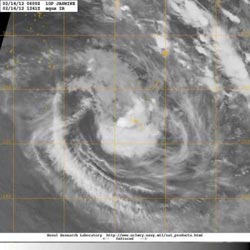NASA sees Tropical Cyclone Jasmine near Tonga

On Feb. 14, 2012 at 1241 UTC (7:41 a.m.), the MODIS instrument on NASA's Terra Satellite captured this infrared image of Cyclone Jasmine near Tonga. The strongest thunderstorms and heaviest rainfall appear to be on the northeastern quadrant of the storm. Credit: NASA/NRL<br>
When Aqua flew over Cyclone Jasmine on February 14, 2012 at 1241 UTC (7:41 a.m.), the Moderate Resolution Imaging Spectroradiometer (MODIS) instrument captured an infrared image of its clouds.
The image showed the strongest thunderstorms and heaviest rainfall appear to be on the northeastern quadrant of the storm.
A gale warning is in force for the Tongatapu group of islands. The islands are experiencing gusty winds and heavy rainfall as Jasmine creeps away slowly.
On February 14 at 0900 UTC, the Joint Typhoon Warning Center noted that Jasmine's center was just 25 nautical miles (28.7 miles/46.3 km) west-southwest of Tonga, near 21.3 South and 175.6 West.
It was bringing gusty winds and rainfall to Tonga today, and is expected to start moving away to the south at 5 knots (~6 mph/~9 kph). Jasmine's maximum sustained winds were near 45 knots (~52 mph/~83 kph) but it is expected to strengthen a little as it moves away through warmer waters.
Media Contact
More Information:
http://www.nasa.govAll latest news from the category: Earth Sciences
Earth Sciences (also referred to as Geosciences), which deals with basic issues surrounding our planet, plays a vital role in the area of energy and raw materials supply.
Earth Sciences comprises subjects such as geology, geography, geological informatics, paleontology, mineralogy, petrography, crystallography, geophysics, geodesy, glaciology, cartography, photogrammetry, meteorology and seismology, early-warning systems, earthquake research and polar research.
Newest articles

Superradiant atoms could push the boundaries of how precisely time can be measured
Superradiant atoms can help us measure time more precisely than ever. In a new study, researchers from the University of Copenhagen present a new method for measuring the time interval,…

Ion thermoelectric conversion devices for near room temperature
The electrode sheet of the thermoelectric device consists of ionic hydrogel, which is sandwiched between the electrodes to form, and the Prussian blue on the electrode undergoes a redox reaction…

Zap Energy achieves 37-million-degree temperatures in a compact device
New publication reports record electron temperatures for a small-scale, sheared-flow-stabilized Z-pinch fusion device. In the nine decades since humans first produced fusion reactions, only a few fusion technologies have demonstrated…





















